 ?Mathematical formulae have been encoded as MathML and are displayed in this HTML version using MathJax in order to improve their display. Uncheck the box to turn MathJax off. This feature requires Javascript. Click on a formula to zoom.
?Mathematical formulae have been encoded as MathML and are displayed in this HTML version using MathJax in order to improve their display. Uncheck the box to turn MathJax off. This feature requires Javascript. Click on a formula to zoom.Abstract
The present study was conducted to assess the effect of some pretreatments, and drying methods on the microbial loads, and sensory acceptability of dried mango slices during storage periods. Four pretreatments (lemon juice, salt solution dips, hot water blanching, and control) and four drying methods (solar, tray, freeze, and fluidized bed drying) were considered and arranged in factorial experimental design. The microbial loads and sensorial acceptance of dried mango slices during storage times were evaluated. The result showed that the pretreatments and drying methods exhibited significant effects on the microbial load and sensory acceptance of the dried mango slices during storage periods. It could be inferred that the total plate count of dried mango slices ranged from 1.4 × 102 to 9.6 × 103 CFU/g while yeast and mould were 4.2 × 101 to 8.2 × 101 CFU/g during storage periods; it could be concluded that drying of the mango slices with those pretreatments and drying methods assured the microbial safety of the product for storage periods of 90 days. Generally, the overall acceptance of dried mango slice was good during three months of storage periods on the 7-point Hedonic scale, these indicate that the slices made from mangoes would be accepted when introduced into the market.
PUBLIC INTEREST STATEMENT
Mango fruit is one of the most common nutritionally rich fruits with a unique flavour, scent, taste and health-promoting qualities, which makes it plentiful among new functional foods, also labelled as a super fruit. It is rich in pre-biotic dietary fibre, vitamins, minerals, and antioxidants. It has been found to protect against colon, breast, leukaemia and prostate cancers according to the new studies. However, like other fresh fruits, mango has high water content which makes it highly perishable. Considering the incessant rise of losses, searching for less expensive post-harvest technologies are very important. Drying mangoes is an ideal value-added opportunity for processors in many developing countries. The results of the present study demonstrated that it is possible to get acceptable dried mango slices with the shelf life of up to three months. Therefore, drying could be indeed contributed to reducing the postharvest losses and realized effectively for the preparation of dried mango slices that have low microbial load and better sensory properties.
Competing interest
The authors declare no competing interests.
1. Introduction
Mango is a fleshy stone fruit from the panes Mangifera (Shah et al., Citation2010), tropical fruit of highly seasonal and one of the most popular fruits of the planet (Sehrawat et al., Citation2018). It is second in production in Ethiopia (Neguse et al., Citation2019) and one of the most nutritionally rich fruits with a unique flavour, scent, taste and health-promoting qualities, which makes it plentiful among new functional foods. According to Ethiopia Fresh Fruits Market update report, production of mango increased by 45% from 2013/14 to 2017/18. However, considering these substantial quantities of mango fruit, the processing industry in Ethiopia is very weak (Hagos et al., Citation2019). In most situations, vendors and retailers buy the mango fruits from fruit collectors and from the people with the fruit tree at their home and transport them to urban markets where they sell them to other vendors, and to customers and some of the fruits exported to some countries.
Despite its nutritional, economics and health importance, production of mango is constrained by post-harvest losses, which limits the volumes of good quality products reaching consumers. Hence, searching for less expensive post-harvest technologies are very important to reduce the loss of this king of fruits, benefits the growers, create jobs, contributes to food security, encourage large scale processing and availing the products during off-seasons. The drying of fruits is one of the simplest and common methods used to avoid post-harvest losses and increase the shelf life of fruits. In recent times, several pretreatments along with drying methods support to minimize the thermal change of the sensory qualities of the dried products during drying and storage period and can maintain low microbial load, thus making it possible for the dried products to be widely available.
In consequence to avoid post-harvest losses and increase the shelf life mango has to be processed into shelf-stable products such as dried mango slices. However, in Ethiopia researches in the drying of fruits in general and mango fruits, in particular, is in serious shortage and dried fruit products are barely available on market. Likewise, information on using different pretreatments and drying methods and their effect on sensorial and microbial quality of dried mango products are lacking. Sensory attributes such as colour, visual appeal, flavour, taste and texture and microbial load are among the major quality parameters that are associated with dried food products. However, the time of acceptability of dried food products is reduced due to microbiological and chemical changes and it is not safe for consumption after some time. Thus, this research was initiated to assess the effect of some pretreatments and drying methods on microbial loads and sensory acceptability of dried mango slices during the storage period.
2. Materials and methods
Fresh, healthy and disease-free mango fruits of the Keitt cultivar used in this experiment were collected in plastic bags from Asossa, Benishangul Gumuz Regional State, Ethiopia. The average initial moisture content was 80.03% (w.b). The weights of the whole (peels, pulps and seeds) and the inedible portion (peels and seeds) fresh mango fruits were measured using an analytical balance (ML303T, Switzerland) to be 319.3 g and 60.53 g, respectively. The soluble solid content was determined by a refractometer (Bellingham Stanley Ltd., England) found to be 11.59 °Brix and the average pH and titratable acidity of the fresh mango slice were 3.86 and 1.92 g/100 g, respectively. The total vitamin C content in the fresh mango samples was, on average, 49.53 mg/100 g. The moisture content, pH, total soluble solids, titratable acidity (citric acid) and vitamin C of the dried mango slices, respectively were 5.63 to 9.91% (w.b), 3.17 to 3.68, 69.36 to 86.29ºBrix, 2.20 to 2.54 g/100 g and 33.18 to 41.24 mg/100 g.
2.1. Experimental plan
The experiment was set in a 4 × 4 factorial arrangement involving four pretreatments, that were lemon juice, salt solution, hot water blanching and control (untreated) before drying and four drying methods (solar, tray, freeze and fluidized bed drying), arranged in a completely randomized design (CRD) and each treatment being triplicated.
2.2. Sample preparation
The mangoes were cleaned, peeled and the flesh sliced manually in the direction parallel to their fibres to a thickness of approximately 5 mm (Adepoju & Osunde, Citation2017) with a sharp stainless steel knife (Inox stainless, Brazil). These slice materials were categorized into 200 g each and treated with each pretreatment before drying.
2.2.1. Lemon juice dips
The slices were subjected to the pretreatment of equal parts of lemon juice and distilled water mixed solution 0.5 v/v (Abano et al., Citation2013; Abano & Sam-Amoah, Citation2011) in the container (Op plastics, Ethiopia) ensuring full coverage of the slices and allowed for 10 minutes. The pretreated slices were removed from the solution and spread evenly over a perforated tray, allowing the excess solution to drip for 20 minutes (Nyangena et al., Citation2019).
2.2.2. Hot water blanching
One minute hot water blanching was done by subjecting the sliced mangoes at 90°C (Doymaz, Citation2010; Galoburda et al., Citation2012; Wang et al., Citation2018) in a water bath (BM 30, Turkey) ensuring full coverage of the slices by water.
2.2.3. Salt solution dips
The samples of sliced mangoes were soaked in the solution prepared by 0.011 g/mL (Abano et al., Citation2013; Abano & Sam-Amoah, Citation2011) for 10 minutes in the container (Op plastics, Ethiopia) ensuring full coverage of the slices. The pretreated slices have been removed from the solution and spread evenly over a perforated tray, allowing the excess solution to drip for 20 minutes (Nyangena et al., Citation2019).
2.2.4. Control
One sample was untreated and served as the control.
2.3. Drying methods
Solar drying of mango slices was carried out in a solar dryer (YYF-2-7112P1, China). Different sides of the slices were turned to increase drying efficiency regularly. A digital hygrometer (PWT-105, China) was used to measure the temperature and relative humidity at the entrance of the collector and the drying chamber.
Tray drying of mango slices was carried out in a computer-controlled tray drying (SBANC, Madrid, Spain). The drying temperature was maintained at 70°C.
A laboratory-scale freeze dryer (Lablyo plus, Germany) was used to dry mango slices according to Marques et al. (Citation2011), Kaewdam et al. (Citation2013), and Izli et al. (Citation2017). The drying was with total pressure and the temperature inside the vacuum chamber of 52 Pa and—52°C respectively. The prepared slices were arranged in a single layer on the trays and placed inside the freeze dryer chamber. Thermocouple probes were used to control and monitor the product temperature on each tray during drying.
A batch type laboratory-scale fluidized bed dryer (TG 200, Germany) was used to dry the prepared mango slices. An air temperature of 50°C and an airflow of 1.5 m/s was set digitally (Quintana-Zaragoza et al., Citation2017).
All the samples were dried until the moisture content of the samples dropped below 10% wet basis.
2.4. Storage of dried mango slices
After the drying process, the dried mango slices were cooled in desiccators, enclosed in zip lock bags and coated with aluminium foil before storage at room temperature until further testing was required. Microbiological and sensory analyses of the dried mango slices were conducted at an interval of four weeks during the storage period.
2.5. Determination of the microbial load of dried mango slices
The microbial qualities of the dried fruits were assessed by using the total number of bacteria, mould, and yeast analyses (AOAC, Citation2005). All the colonies were counted using colony counter (362: ISO 9001: 2008 certified, England).
2.6. Sensory evaluation
Sensory evaluation was conducted by using randomly selecting 30 semi-trained panellists were participated from Food Process Engineering of Wolkite University senior students and staff. Individually panelist was requested to read and sign an informed consent form. The observations were made at the one-month interval for organoleptic properties. The panellists were asked to evaluate the descriptors, rating each sample on a 7-point Hedonic scale. Dried mango slices were analyzed for colour, flavour, taste, texture, and overall acceptability (S. Kumar & Shukla, Citation2017). The sensory scale included: like extremely = 7, like moderately = 6, like slightly = 5, neither like nor dislike = 4, dislike slightly = 3, dislike moderately = 2, dislike extremely = 1.
2.7. Statistical analysis
Statistical analysis was carried out using the software package SAS (SAS Institute, Inc., Cary, North Carolina, USA) by using analysis of variance (ANOVA) for complete randomized design with the factorial arrangement. The results were reported as average value of triplicate analysis of (mean ± SD). Fisher’s Least Significance Difference (LSD) test at the significance level 5% was used to determine significant differences among samples.
3. Results and discussion
3.1. Effect of pretreatments and drying methods on microbial loads of dried mango slices during storage
To ensure product safety, microbiological exams such as a total plate, yeast and mould count were performed and results shown in Figure to . Aerobic bacteria were found in almost all the dried mango slices dried by solar and tray driers after being subjected to the pretreatments, but the counts were fairly low, compared to the first, second, and third month, where the plates had high-count microbes. Plate-counting agar indicates the sanitary conditions of processed food during producing (FAO, Citation1992). As indicated in Figure to , freeze and fluidized bed-dried samples after being subjected to the four pretreatments offered samples with the below detectable level of aerobic bacteria during the first month and also the second and third month of storage was again the counts were relatively low with a range 1.2 102 to 3.9
102 CFU/g. This low values guaranteed that the entire product was safe for consumption. The recommended value for plate counts and yeast and fungi should not exceed 5
104 and 1.0 × 103 CFU/g (FDA, Citation2012; Witthuhn et al., Citation2005).
Figure 1. Effect of pretreatments and solar drying on the bacterial counts of dried mango slices during storage periods for three months. Data are means±SD. Note: SL, SB, SS, SC = Solar drying with lemon juice, hot water blanching, salt solution dip and control sample, respectively.
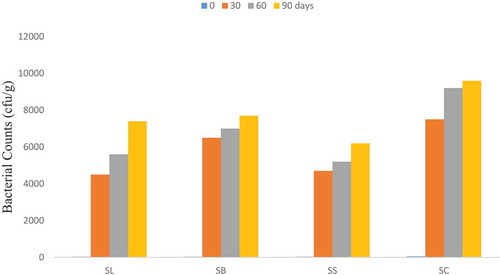
Figure 2. Effect of pretreatments and tray drying on the bacterial counts of dried mango slices during storage periods for three months. Data are means±SD. Note: TL, TB, TS, TC = Tray drying with juice, hot water blanching, salt solution dip and control sample, respectively.
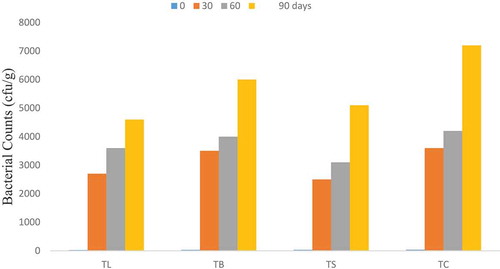
Figure 3. Effect of pretreatments and freeze drying on the bacterial counts of dried mango slices during storage periods for three months. Data are means±SD. Note: FL, FB, FS, FC = Freeze-drying with lemon juice, hot water blanching, salt solution dip and control sample, respectively.
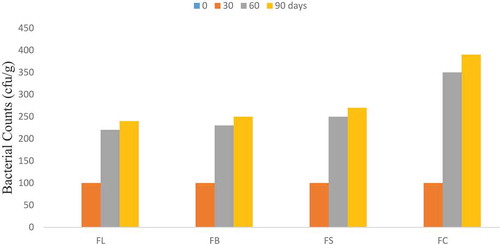
Figure 4. Effect of pretreatments and fluidized bed drying on the bacterial counts of dried mango slices during storage periods for three months. Data are means±SD. Note: FBL, FBB, FBS, FBC = Fluidized bed drying with lemon juice, hot water blanching, salt solution dip and control sample, respectively.
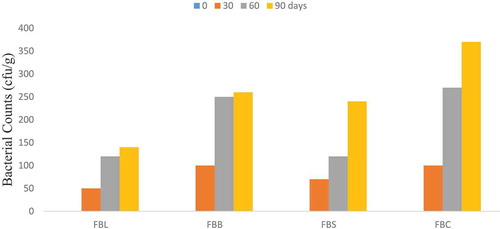
During the 30 days of storage, fungal counts were not detected on dried mango slices dried by freeze and fluidized bed driers after being subjected to the pretreatments. Yet the sums were fairly low, with the exclusion of the second and third months, where high counts were noticed. The non-detection of microbes indicates good hygienic and handling practices (Ntuli et al., Citation2017). The solar and tray dried samples had high microbial counts varying from 3.5 × 101 to 9.6 × 103 CFU/g and 2.6 × 101 to 7.5 × 103 CFU/g observed during the storage periods (Figures and ). These an increment of microbial loads in those driers may result in low short shelf life. To reduce the pathogenic prevalence of dried fruits and vegetables, strict quality standards must be implemented and enforced (Ntuli et al., Citation2017).
Figure 5. Effect of pretreatments and solar drying on the fungal counts of dried mango slices during storage periods for three months. Data are means±SD. Note: SL, SB, SS, SC = Solar drying with lemon juice, hot water blanching, salt solution dip and control sample, respectively.
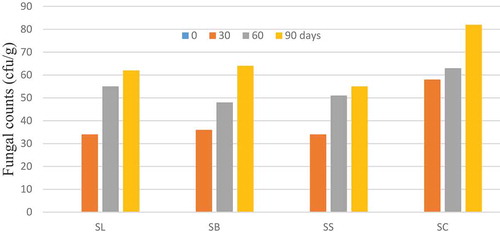
Figure 6. Effect of pretreatments and tray drying on the fungal counts of dried mango slices during storage periods for three months. Data are means±SD. Note: TL, TB, TS, TC = Tray drying with juice, hot water blanching, salt solution dip and control sample, respectively.
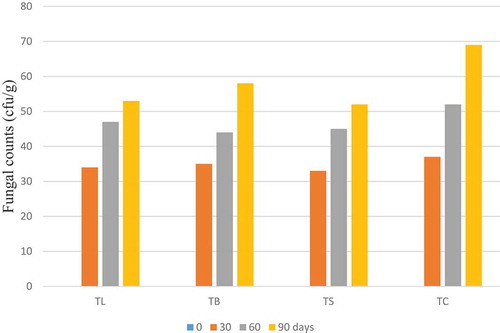
The maximum bacterial counts 3.7 × 102 and 3.9 × 102 CFU/g were observed for control samples dried by the fluidized bed and freeze driers, whereas 9.6 × 103, and 7.2 × 103 CFU/g were observed in samples dried by solar and tray driers on the third month of storage periods, respectively (Figures , , and ). Likewise, the highest fungal counts were found in the samples dried without being pretreated (control) (Figures , , , and ). Though the microbiological counts depended on the interplay between all the pretreatments and drying methods. Adding lemon juice and salt solution as pretreatments may be some of the factors that regulate the microbial load at an acceptable level and but also barred any marked proliferation of microbial populations with the sample during the storage. Similar to the results of the present study, Mugodo (Citation2017) reported that the lowest total aerobic count for the lemon juice treated as compared to those control dried mangoes. Overall, the average microbial population was higher on the dried mango slices by solar and tray than freeze and fluidized bed dried samples. Yet, the growth was tiny as far as the permissible limits were not alarmed.
Figure 7. Effect of pretreatments and freeze drying on the fungal counts of dried mango slices during storage periods for three months. Data are means±SD. Note: FL, FB, FS, FC = Freeze-drying with lemon juice, hot water blanching, salt solution dip and control sample, respectively.
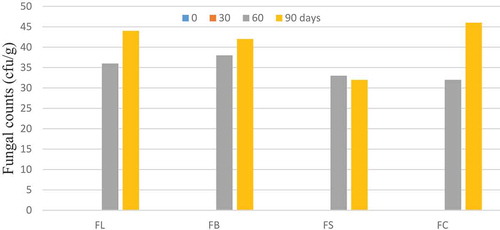
Figure 8. Effect of pretreatments and fluidized bed drying on the fungal counts of dried mango slices during storage periods for three months. Data are means±SD. Note: FBL, FBB, FBS, FBC = Fluidized bed drying with lemon juice, hot water blanching, salt solution dip and control sample, respectively.
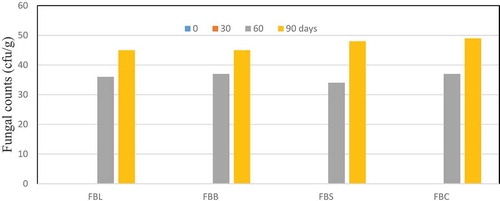
The bacterial count in this study was higher than that reported by Ntuli et al. (Citation2017) but, the fungi were lower than their result 1.0 × 103 and 4.2 × 103 CFU/g, respectively for dried mango after the third-month storage. The lowest fungal counts were detected in the freeze and fluidized dried samples (4.6 × 101 and 4.9 × 101 CFU/g), after the third month of storage times as compared to that of solar and tray dried samples. The reason for low microbial load might be due to the low moisture contents of the samples dried in the former driers. Low moisture content delays spoilage by yeast, bacteria, moulds, and enzymes (Scanlin, Citation1997). Throughout the storage period, it was found that there was a very slight increase in the total plate count invariably in all samples. Hence, it could be inferred that drying of the slices with those pretreatments and drying methods assured the microbial safety of the product for a storage period of 90 days. Overall, the result of total plate count and fungi count showed that the dried mango slices were less susceptible to microbial, and found in the safe limit according to FDA recommendations. Therefore, the minimum shelf life of the dried mango slice was 90 days.
3.2. Sensory evaluation
3.2.1. Effect of pretreatments and drying methods on sensory acceptability of dried mango slices
The seven point hedonic scale was used to evaluate the acceptability of dried mango slices in the sensory attributes. Panellists, as shown in Table , rated the sensory attributes of dried mango slices including, colour, flavour, taste, texture, and overall acceptability of dried mango. Based on colour, statistical analysis of the hedonic test showed that the samples dried by fluidized bed scored the highest 6.14, whereas the tray dried scored the lowest 4.88 in a scale of seven hedonic point. The mean values of dried mango slices for colour ranged from 5.85 to 5.23 for those pretreatments (Table ). The highest value was those samples pretreated with lemon juice and backed the findings of Masamba et al. (Citation2013), who reported that the lemon juice treated dried mango samples showed better colour acceptance than control samples by the panellists. Both pretreatments and drying methods showed significant differences (P < 0.05) on the colour. According to Hwa et al. (Citation2013), the colour of dehydrated fruit is essential as the first product judgment is colour. Even if the product had good taste and flavour, off colour of food products is often unacceptable (Gulzar et al., Citation2018). The samples dried with fluidized bed and freeze driers after being subjected to pretreatments showed significant (P < 0.05) differences among them except for few for colour (Table ).
Table 1. The sensory acceptability of dried mango as affected by pretreatments and drying methods
Table 2. The sensory acceptability of dried mango as affected by the interactions of pretreatments and drying methods
Regarding flavour, taste, and texture acceptability, the data appread to have no statistical (P > 0.05) differences among samples dried by solar and tray driers but statistically were lower than freeze and fluidized bed dried products that showed significant (P < 0.05) differences among them. Except for flavour where the control samples scored the highest value 5.58, the pretreatments did not show a significant difference between them for the taste and texture of the dried mango slices. The values appeared to have no statistical (P > 0.05) difference.
For the texture, the results are similar to those outlined by Masamba et al. (Citation2013), who did not notice a significant difference between the control and treated samples of dried mango among the judges. It’s one of the main sensory quality attributes affecting food acceptance (Ikoko & Kuri, Citation2007). It can be seen that the overall score of mango slices dried by the freeze and fluidized bed resulted in the highest score with no significant difference between them. Although mango slices dried by solar and tray driers were not as high as that of freeze and fluidized bed-dried products, these scores were also high to seven points, which means that consumers can accept these dried mango slices.
The mean score for flavour ranged from 4.97 to 6.03 for the sample dried by solar and fluidized bed drying methods with lemon juice and hot water blanching treatments, respectively (Table ). On the other hand, the solar-dried samples after being subjected to lemon juice treatments scored the lowest mean (4.93) for taste while the sample dried by fluidized bed without treatments scored the highest (6.17). It was well known that to market a product successfully in the food industry, the one criteria required is good taste; without this attribute, many products would short-lived in any global market. The fluidized bed dried mango slices after being subjected to the pretreatments showed the highest mean for the texture. Sensory testing is a way of determining whether the variations between the brand and the differences are perceived and whether one product is more liked than another (Stone, Citation2018).
For overall acceptability, lower scores were obtained for control samples, though when comparisons were made between the four pretreatments, no significant differences while when three samples were compared with the control samples, significant differences were observed. Similar observations made by Abano et al. (Citation2013) and Masamba et al. (Citation2013), who reported that lemon juice pretreatment influences the panellists scoring on flavour, colour and overall acceptability of dried mango. In general, the overall preference for all the dried samples was above 4.90, indicating that all products were well-liked by the judges (Table ). Scores from the sensory evaluation can reflect consumer preference (Zou et al., Citation2013).
3.2.2. Effect of pretreatments and drying methods on sensory acceptability of dried mango slices stored for one month of storage periods
The colour scores by the hedonic test indicated that samples dried by solar and tray driers ranged from 4.69 to 4.75 with no significant (P > 0.05) difference among them, whereas freeze and fluidized bed dried samples ranged from 5.70 to 5.94 with significant (P < 0.05) difference between them (Table ). Lemon juice treated samples scored the highest value (5.49), and the control scored the lowest value (5.05) with significant differences between the pretreatments. The actual records of colour score ranged between 4.47 and 6.37 (Table ). The highest mean score of colour was recorded for samples dried by fluidized bed dryer after being subjected to lemon juice pretreatments, and that of the lowest was that of the control samples dried by tray dryer (Table ).
Table 3. The sensory acceptability of dried mango as affected by pretreatments and drying methods stored for a month
Table 4. The sensory acceptability of dried mango as affected by the interactions of pretreatments and drying methods after a month of storage periods
As shown in Table , flavour, taste, and texture of the samples dried by fluidized bed dryer scored the highest 5.84, 6.02 and 5.97, followed by freeze-dried samples with a significant difference between them. This may be due to their aesthetic colour, scent flavour, pleasant taste, and blameless texture. In contrast, solar and tray, dried samples scored the lowest with no significant difference among them. Those samples dried by fluidized bed dryer after the hot water blanching scored the highest value 5.90 for flavour (Table ). Control samples dried using tray dryer had the lowest value of taste 4.77 (Table ). The highest acceptability for the texture was observed in samples dried by freeze and fluidized bed driers after all pretreatments. From Table , sensory analysis results showed that the average overall acceptability of the dried mango is highest for all samples of freeze and fluidized bed as compared to solar and tray driers after subjected to different pretreatments.
The overall acceptability of samples dried by solar and tray were 5.64, and 5.52, with no significant difference between them (Table ). On the other hand, samples dried by freeze and the fluidized bed had 6.40 and 6.26, again with no statistical difference among them. The two groups showed a significant difference between them. Control samples showed the lowest value (5.47) for the overall acceptability. Even though the overall preference for all the dried samples was reduced from that of the previous month (5.58), current it was above (5.52) indicating, that all products were well-liked by the judges. The overall preference for all the dried samples was above (4.80), indicating that all products were well-liked by the judges (Table ). The overall acceptance of the new value-added product was evaluated using sensory analysis (P.S. Kumar & Sagar, Citation2012; Velickova et al., Citation2013) such as colour, flavour, taste, visual appearance (Mishra et al., Citation2019).
3.2.3. Effect of pretreatments and drying methods on sensory acceptability of dried mango slice stored for two months of storage periods
As can be seen in Table , the colour, flavour, taste, texture, and overall acceptability of dried mango slices ranged between 5.31 to 4.39, 5.70 to 4.91, 5.85 to 4.85, 5.65 to 5.00, and 5.99 to 5.18 in the scale seven indicating moderate level of acceptability. The fluidized bed dried mango slices showed the highest values for all the sensory properties out of seven hedonic points. It was evident from Table that the tray and solar dried mango slices after two months of storage periods did not show significant differences among the sensory properties in terms of flavour, taste, and texture attributes while it was significantly different in terms of the colour and overall acceptability. None of the scores were below 4 points thus showed one or another degree of liking.
Table 5. The sensory acceptability of dried mango as affected by pretreatments and drying methods after a two month of storage periods
Except for the flavour, where the pretreatments did not show a significant difference between them, but in other sensory attributes, the control samples scored the lowest values (Table ) showing that the pretreatments processes somehow helped to improve acceptability of the product. When comparisons were made between the lemon juices, hot water blanched and salt solution pretreated samples, no significant differences while when three samples were compared with the control samples, significant differences were observed. Even though the overall preference of all the dried mango slices was reduced from that of the first month, up-to-date, it was above 5.18, indicating that all products were well-liked by the judges. Sensory assessment is a science that analyzes interventions and interprets people’s responses to sensory items (Stone, Citation2018). According to Velickova et al. (Citation2013), their value, strength and reciprocal relationships are extremely significant to brand recognition and consumer acceptance, particularly when a product newly developed is being evaluated.
The preference rating for the colour of the solar and tray drying methods ranged from 4.03 to 4.60 with a statistical (P < 0.05) difference between them except for very few (Table ). On the other hand, those samples dried with freeze and fluidized bed driers ranged between 4.63 and 5.50 are higher groups showing significant differences among them (Table ). Significant (P < 0.05) difference was observed between the first and the second groups. The flavour of the samples ranged from 4.73 to 5.80 with a statistical (P < 0.05) difference among them except for a very few. As shown in Table , the top eight records belonged to samples dried in the freeze, and fluidized bed driers after the four different pretreatments.
Table 6. The sensory acceptability of dried mango as affected by the interactions of pretreatments and drying methods after a two month of storage periods
The taste of those samples, which had been dried in the tray, was less preferred than solar, freeze and fluidized bed drying methods with their combined pretreatments. Significant (P < 0.05) differences were observed on the values of the samples subjected to different treatment combinations. It ranged from 4.33 of those control samples dried in the tray to 5.93 of those treated with salt solution and dried in fluidized bed dryers. The top four records belonged to samples dried in fluidized bed dryers after the four different pretreatments. As shown in Table , except fluidized bed dried samples, the preference rating for the texture of the samples that had been pretreated with hot water blanching and the salt solution was not significantly different from each other in each group. As expected, the fluidized bed and freeze-dried samples had a higher overall acceptances than that of solar and tray dried samples with their pretreatments used.
3.2.4. Effect of pretreatments and drying methods on Sensory attributes of dried mango stored for three months of storage periods
As shown in Table , except the flavour, solar and tray dried mango samples were significantly different (P < 0.05) from each other. Similarly, solar and freeze-dried samples were significantly different (P < 0.05) from each other except for the overall acceptability. Samples obtained using the fluidized bed drying methods, received high acceptability scores ranging from 5.18 to 5.68 in all five sensory attributes. On the other hand, there was a significant (P < 0.05) differences among the samples subjected to hot water blanching and salt solution and that of lemon juice and control in terms of colour and taste. There was no significant difference between the lemon juices, hot water blanching, and salt solution pretreated samples in terms of the overall acceptability, but these three were significantly different from control samples. The tray-dried sample had the lowest value of colour, which may be due to its slightly darker colour after the storage periods.
Table 7. The sensory acceptability of dried mango as affected by the pretreatments and drying methods after a three month of storage periods
It was observed that loss of colour, flavour, taste, texture, and overall acceptability was maximum in the tray-dried samples. The results showed that lower scores for overall acceptability were found in all dried mango samples, which might be related to the sensory attributes losses during the storage periods. Also, flavour, and texture of dried mango samples did not show significant differences among them due to the pretreatments on the third month of storage periods. Significant differences were found in colour, taste and overall acceptance among samples pretreated with lemon juice, hot water blanching and salt solutions and that of control samples that scored lower values. Generally, the overall acceptance of the samples pretreated with different pretreatments and dried with the four drying methods was good and tended to be liked by the consumers even though samples were tasted without the addition of any ingredient even though after the third month of storage periods.
Sensory acceptability evaluation data of the dried samples after three months of storage time are shown in Table . There was no significant difference between the preference rating of the colour among solar and tray drying methods combined with hot water blanching, and salt solution pretreated samples, whereas significant difference and high scores were noted among the freeze and fluidized bed drying methods with their combination of the pretreatments. Similarly, samples dried with solar and tray after subjected to the pretreatments had scored the low values for the flavour attributes with no significant difference among them whereas those samples dried with freeze, and fluidized bed driers after subjected to all the pretreatments had the highest values with significant (P < 0.05) difference between them.
Table 8. The sensory acceptability of dried mango as affected by the interactions of pretreatments and drying methods after a three month of storage periods
The taste score of those samples, which had been dried in-tray, was less than those of solar, freeze and fluidized bed drying methods with their combined pretreatments. The interactions of the pretreatments and drying methods did not show significant differences between each group, but there was a significant difference among the solar, tray and freeze, fluidized bed dried samples. As expected, the fluidized bed and freeze-dried samples had the highest overall acceptances than that of solar and tray dried samples with their pretreatments used. The dried samples was not much appreciated even though it was not rejected sensorially, all the dried products, except for the control tray, dried samples scored at least well after stored for three months.
Furthermore, the sensory analysis showed that the product dried by the fluidized bed dryer subjected to different pretreatments had the highest overall acceptability scores after the month of storage. This high values could be because the fluidized bed dried samples had the most preferred colour, which was usually one of the first attributes of any food product encountered and has an influence on consumer perception of food by evoking an initial response from the consumer. From data obtained on the sensory evaluation of samples using the hedonic scale used, slices made from mangoes would be accepted when introduced into the market. However, a decrease was observed in sensory attributes of mango slices with the increase in days of storage. This decreasing might be due to microbial action on the slices components during storage periods. The components of dried food product quality include safety, flavour, texture, colour, healthfulness, and shelf life (Perera, Citation2014). Statistical analysis of the effect of pretreatments and drying methods on the sensory quality of the dried mango slices showed pretreatments and drying methods, and their interaction had significant effects on sensory quality.
4. Conclusions
The present study shows that the selected pretreatments and drying methods produced better-dried mango slices with low microbial loads with well-liked sensory acceptability. It becomes clear from our findings that additions of those selected pretreatments and freeze and fluidized bed drying method resulted in the better the sensory quality of dried mango slices. Except for a few attributes, there was no significant difference between the lemon juices, hot water blanching, and salt solution pretreated samples, but these three were significantly different from control samples. Although mango slices dried by solar and tray driers were not as high as that of freeze and fluidized bed-dried products, the scores were also high to seven points hedonic scale, which means that consumers can accept these mango slices. It can, therefore, be concluded that the driers used significantly affected the sensory quality attributes of the dried mango slices in different ways. Drying methods, pretreatments and storages times have pronounced effects on microbial loads and sensory properties of dried mango slices. Throughout the storage period, it was found that there was a very slight increase in the total plate and fungal count invariably in all samples. It could be inferred that drying of the slices with those pretreatments and drying methods assured the microbial safety of the product for a storage period of 90 days. Sensory acceptability data of dried mango slices showed a decrement scores of all attributes as the days of storage times increased. However, from data obtained on the sensory evaluation of samples using the seven hedonic scale used, slices made from mangoes would be accepted when introduced into the market. It can further be concluded that the pretreatments and drying methods had the potential to extend the shelf life of dried mango slices up to three months.
Acknowledgements
Firstly, the author is thankful to the Department of Food Process Engineering and Biology of Wolkite University. The author also thank Addis Ababa Science and Technology University.
Data availability
The data used to support the findings of this study are available from the corresponding author upon request.
Additional information
Funding
Notes on contributors
Belay Dereje
Belay Dereje is a lecturer and researcher in the Department of Food Process Engineering at Wolkite University, Ethiopia. His key research areas are on drying technology, new product development and food safety.
Solomon Abera
Solomon Abera is an assistant professor in the Department of Food Technology and Process Engineering, and Food Science and Postharvest Technology, Haramaya University, Ethiopia. He has a great aspiration to work in the research area of agro-food engineering.
References
- Abano, E. E., Owusu, J., & Engmann, F. N. (2013). Effects of ascorbic acid, salt, lemon juice, and honey on drying kinetics and sensory characteristic of dried mango. Croatian Journal of Food Science and Technology, 5, 1–17.
- Abano, E. E., & Sam-Amoah, L. K. (2011). Effects of different pretreatments on drying characteristics of banana slices. Journal of Engineering Applied Sciences, 6, 121–129.
- Adepoju, L. A., & Osunde, Z. D. (2017). Effect of pretreatments and drying methods on some qualities of dried mango (Mangifera indica) fruit. Agricultural Engineering International CIGR
- AOAC. (2005). Association of official analytical chemists: official methods of analysis of AOAC international (18th ed.).
- Doymaz, Ä. (2010). Effect of citric acid and blanching pre-treatments on drying and rehydration of Amasya red apples. Food and Bioproducts Processing, 88(2–3), 124–132. https://doi.org/10.1016/j.fbp.2009.09.003
- FAO. (1992). Manuals of food quality control. USA.
- FDA, 2012. Product Specification Dried Organic Mango Slices FDFI Item code : MANO. Fine Fine dried foods international.
- Galoburda, R., Kruma, Z., & Ruse, K. (2012). Effect of pretreatment method on the content of phenolic compounds, vitamin C and antioxidant activity of dried dill. International Journal of Food Engineering, 6(4).
- Gulzar, A., Ahmed, M., Qadir, M. A., & Imtiaz, M. (2018). Effect of blanching techniques and treatments on nutritional quality of dried mango slices during storage. Polish Journal of Food and Nutrition Sciences, 68(1), 5–13. https://doi.org/10.1515/pjfns-2017-0012
- Hagos, A., Dibaba, R., Bekele, A., & Alemu, D. (2019). Determinants of market participation among smallholder mango producers in Assosa Zone of Benishangul Gumuz Region in Ethiopia . International Journal of Fruit Science, 1–27.
- Hwa, C., Lim, C., Figiel, A., Wojdyło, A., & Oziembłowski, M. (2013). Colour, phenolic content and antioxidant capacity of some fruits dehydrated by a combination of different methods. Food Chemistry, 141(4), 3889–3896. https://doi.org/10.1016/j.foodchem.2013.06.042
- Ikoko, J., & Kuri, V. (2007). Osmotic pre-treatment effect on fat intake reduction and eating quality of deep-fried plantain. Food Chemistry, 102(2), 523–531. https://doi.org/10.1016/j.foodchem.2006.06.008
- Izli, N., Izli, G., & Taskin, O. (2017). Influence of different drying techniques on drying parameters of mango. Food, Science and Technology 68(4), 604–612. https://doi.org/10.1590/1678-457x.28316
- Kaewdam, S., Varith, J., Nitatwichit, C., & Jaturonglumlert, S. (2013). Mathematical model of freeze drying on mango. Journal of Agricultural Research, 30, 56–67.
- Kumar, P. S., & Sagar, V. R. (2012). Drying kinetics and physicochemical characteristics of Osmo- dehydrated Mango, Guava and Aonla under different drying conditions. Journal of Food Science and Technology. https://doi.org/10.1007/s13197-012-0658-3
- Kumar, S., & Shukla, R. N. (2017). Different pre-treatments and storage stability of dehydrated pineapple slices. International Journal of Agricultural Science and Research, 7, 413–424.
- Marques, L. G., Prado, M. M., & Freire, J. T., 2011. Vitamin C content of freeze-dried tropical fruits. In In international congress on engineering and food, (pp. 22–26).
- Masamba, K. G., Mkandawire, M., & Chiputula, J. (2013). Evaluation of sensory quality attributes and extent of vitamin C degradation in dried pineapple, mango and banana fruit pieces pre-treateded with sodium metabisulphite and lemon juice. Global Journal of Food Science and Technology, 1, 20–25.
- Mishra, M., Shukla, R. N., Kandasami, P., & Huirem, B. (2019). Experimental Investigation on the effect of pre-treatments on thin layer drying and quality characteristics of green mangoes in forced convection hot air drying. International Journal of Current Microbiology and Applied Sciences, 8(6), 3112–3124. https://doi.org/10.20546/ijcmas.2019.806.371
- Mugodo, K. (2017). Evaluation of the effects of pre-drying treatments and drying methods on the drying kinetics and quality of tommy atkin mango slices [Msc. Thesis]. University of KwaZulu-Natal.
- Neguse, T. B., Wanzala, F. K. R., Ali, W. M., Owino, W. O., & Mwangi, G. S. (2019). Mango (Mangifera indica L.) production practices and constraints in major production regions of Ethiopia. African Journal of Agricultural Research, 14(4), 185–196. https://doi.org/10.5897/AJAR2018.13608
- Ntuli, V., Peter, C., Raphael, K., Tendekayi, G. H., & Jephris, G. (2017). Microbiological quality of selected dried fruits and vegetables in Maseru, Lesotho. African Journal of Microbiology Research, 11(5), 185–193. https://doi.org/10.5897/AJMR2016.8130
- Nyangena, I., Owino, W., Ambuko, J., & Imathiu, S. (2019). Effect of selected pretreatments prior to drying on physical quality attributes of dried mango chips. Journal of Food Science and Technology, 56(8), 3854–3863. https://doi.org/10.1007/s13197-019-03857-9
- Perera, C. O. (2014). Drying technology: An selected quality attributes of dried foods. International Journal, 23, 37–41.
- Quintana-Zaragoza, L., Luna-Solano, G., Salgado-Cervantes, M. A., Jim´enez-Fernandez, M., Urrea-Garcia, G. R., & Villegas-Santiago, J. (2017). Optimization and experimental validation of fluidized bed drying. Revista Mexicana de Ingenieria Quimica, 16, 625–634.
- Scanlin, D. (1997). The design, construction, and use of an indirect, through-pass, solar food dryer. Home Power, 69.
- Sehrawat, R., Nema, P. K., & Kaur, B. P. (2018). Quality evaluation and drying characteristics of mango cubes dried using low-pressure superheated steam, vacuum and hot air drying methods. LWT - Food Science and Technology, 92, 548–555. https://doi.org/10.1016/j.lwt.2018.03.012
- Shah, K. A., Patel, M. B., Patel, R. J., & Parmar, P. K. (2010). Mangifera Indica (Mango). Pharmacognosy Reviews, 4(7), 42. https://doi.org/10.4103/0973-7847.65325
- Stone, H. (2018). Example food : What are its sensory properties and why is that important? npj. Food Science, 2.
- Velickova, E., Winkelhausen, E., & Kuzmanova, S. (2013). Physical and sensory properties of ready to eat apple chips produced by osmo-convective drying. Journal of Food Science and Technology. https://doi.org/10.1007/s13197-013-0950-x
- Wang, H., Fu, Q., Chen, S., Hu, Z., & Xie, H. (2018). Effect of hot-water blanching pretreatment on drying characteristics and product qualities for the novel integrated freeze-drying of apple slices. Journal of Food Quality, 1–12. https://doi.org/10.1155/2018/1347513
- Witthuhn, R. C., Engelbrecht, S., Joubert, E., & Britz, T. J. (2005). Microbial content of commercial South African high-moisture dried fruits. Journal of Applied Microbiology, 98(3), 722–726. https://doi.org/10.1111/j.1365-2672.2004.02500.x
- Zou, K., Teng, J., Huang, L., Dai, X., & Wei, B. (2013). Effect of osmotic pretreatment on quality of mango chips by explosion puffing drying. LWT - Food Science and Technology, 51(1), 253–259. https://doi.org/10.1016/j.lwt.2012.11.005
